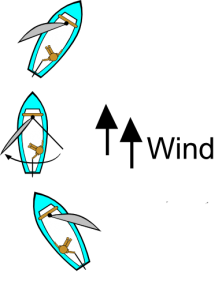Gybing with a sailing yacht, dangerous?
At Happy Sailing, safety is important to us, which is why we recommend that you discuss the explanation below again with the crew so that everyone knows when that boom will come over!
 Gybing is basically the opposite of to go tack.
Gybing is basically the opposite of to go tack.
In either case, the sail comes over and the boat’s sails move from one bow to the other. With tacking this is gradual, however with jibes both mainsail and jib move quickly from one side to the other in 1 go. This makes it a dangerous maneuver with a boat, especially when there is more wind.
You may consider taking a storm lap, this is a lot safer for both crew and boat…
– the helmsman clearly indicates that they are going to jibe and assigns everyone a task.
– The helmsman steers the boat into a wide wind and drops down to before the wind.
– The mainsheet of the mainsail is now tightened.
– The helmsman steers the sailboat even further so that the boat sails “within the wind”. Now the boat is sailing so-called “on the jibe” and the mainsail can come over at any moment.
– By pulling the mainsail a little bit, the mainsail will come over at a great speed.
The moment when this happens is easy to recognize by looking closely at the leech (especially at the top) of the mainsail, it will want to jibe first.
The helmsman then steers the boat slightly back to the new upwind or downwind course.
The jib is simultaneously pulled from the old bow to the new bow.
We advise everyone again to take a storm lap when in doubt, this is actually a tack.
First lurk from broad wind to close to the wind, tack, and then drop to broad wind.
see also the sketch below:
sailing lesson sailboat; storm round or jibe
Would you like to know more about maneuvering a sailing yacht? Then take sailing lessons at Happy Sailing?
This is possible from a few hours!

